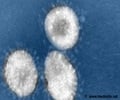An Indian-origin researcher at Purdue University has developed a compound that can prevent the replication of the virus causing Severe Acute Respiratory Syndrome (SARS).
An Indian-origin researcher at Purdue University has developed a compound that can prevent the replication of the virus causing Severe Acute Respiratory Syndrome (SARS).
The findings of the study by molecular design team led by Arun Ghosh, may pave the way for a treatment for the disease."The outbreak of SARS in 2003 led to hundreds of deaths and thousands of illnesses, and there is currently no treatment. Although it is not currently a threat, there is the concern that SARS could return or be used as a biological weapon. It is important to develop a treatment as a safeguard," said Ghosh.
SARS virus, according to the Centers for Disease Control and Prevention, can be transmitted through coughing or sneezing, and the infection can quickly spread from person to person.
Ghosh said that apart form its ability to block the SARS virus, the virus inhibiting molecular compound provides new insights into a group of proteins found in a range of diseases including childhood croup, herpes and cancer.
"The molecular inhibitor we developed is very potent against the SARS virus by binding to and blocking the use of a specific protein, called papain-like protease, or PLpro, involved in viral replication and evasion of the immune system. This is the first design and discovery of an inhibitor for this class of proteins. We are hopeful that this will open the door to new treatments for other diseases as well," said Ghosh.
For the stud Ghosh's team collaborated with a research group led by Andrew Mesecar at the University of Illinois at Chicago.
Advertisement
"Only two of the compounds we tested were identified as having the properties researchers believed could become drugs. Using those two compounds, Arun Ghosh and his team increased the potency by almost two orders of magnitude," said Mesecar, a professor of medicinal chemistry and pharmacognosy.
Advertisement
However, it was Kiira Ratia, a graduate student at the University of Illinois, who provided a breakthrough when she captured the X-ray structure of the inhibitor molecule bound to the protein.
Ghosh claimed that the structure confirmed that the inhibitor would be a good candidate for drug development because it showed that the inhibitor did not bond too strongly to the protein.
"This was the first time the structure was revealed and we could see that the inhibitor filled the active site of the protein without using strong covalent bonds. This is very important for development of a therapeutic treatment because it means there is less of a chance for adverse side effects or toxicity, and the treatment can be easily reversed," he said.
The study has been published in the online version of the journal Proceedings of the National Academy of Sciences.
Source-ANI
SK









